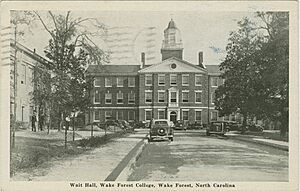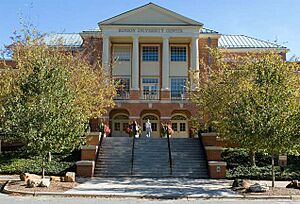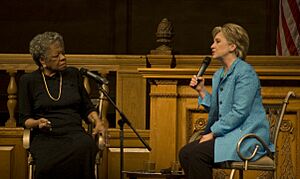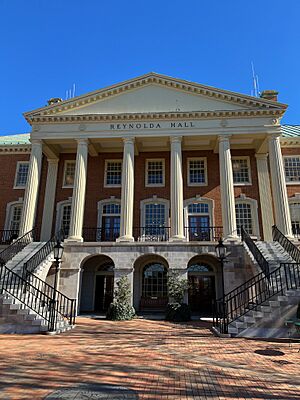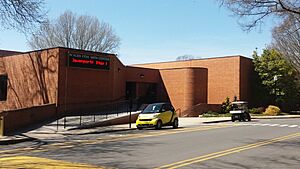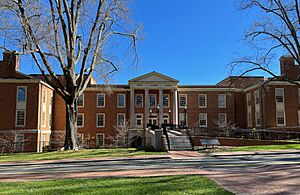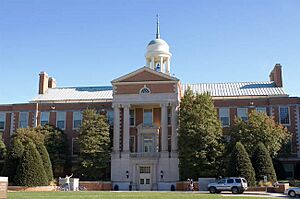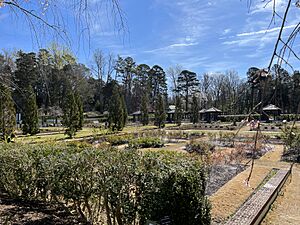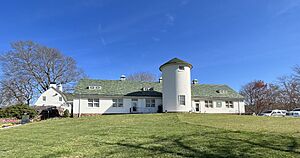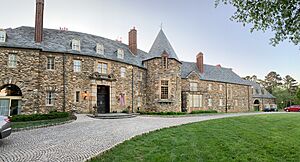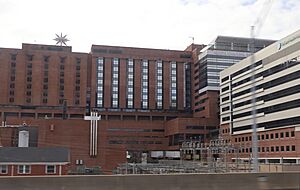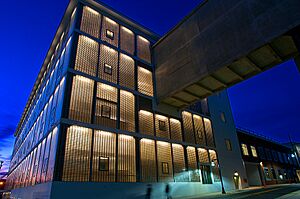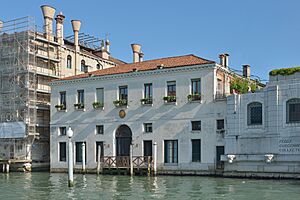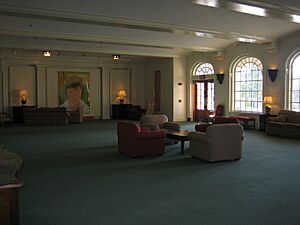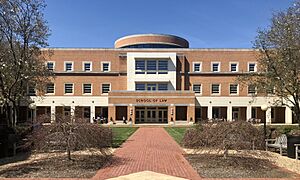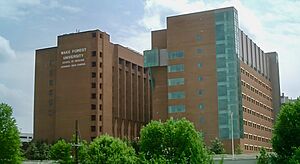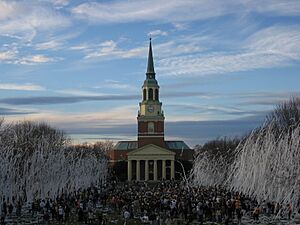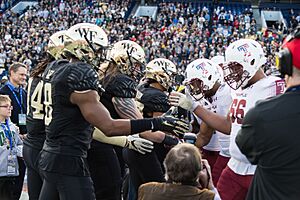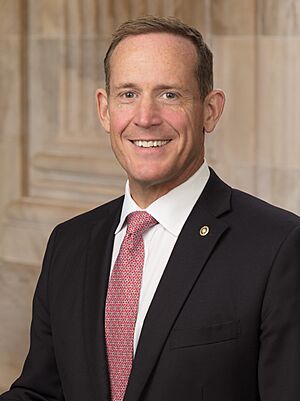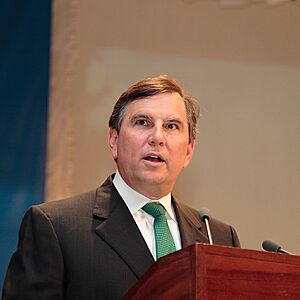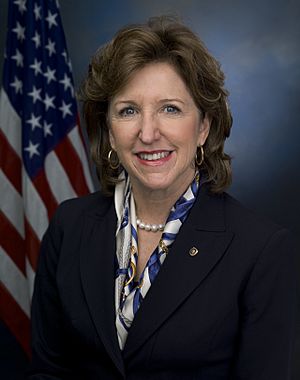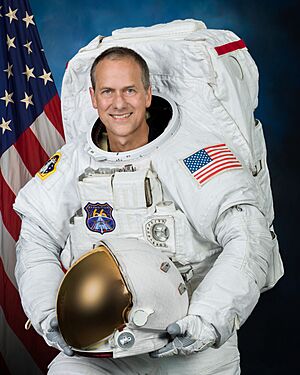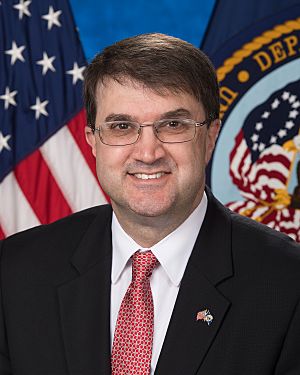Wake Forest University facts for kids
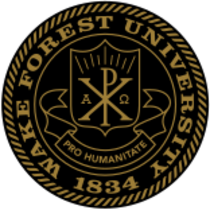 |
|
|
Former names
|
Wake Forest Manual Labor Institute (1834–1839) Wake Forest College (1839–1967) |
|---|---|
| Motto | Pro Humanitate (Latin) |
|
Motto in English
|
"For Humanity" |
| Type | Private research university |
| Established | February 3, 1834 |
| Founder | Baptist State Convention of North Carolina |
| Accreditation | SACS |
|
Religious affiliation
|
Nonsectarian; (historically Baptist until 1986) |
|
Academic affiliations
|
|
| Endowment | $1.99 billion (FY2024) |
| President | Susan Wente |
| Provost | Nell Jessup Newton (Interim) |
|
Academic staff
|
6,667 (includes full- time faculty and staff) |
| Students | 9,121 (fall 2023) |
| Undergraduates | 5,471 (fall 2023) |
| Postgraduates | 3,650 (fall 2023) |
| Location |
,
,
United States
36°08′02″N 80°16′34″W / 36.134°N 80.276°W |
| Campus | Midsize City,, 340 acres (140 ha) |
| Newspaper | Old Gold & Black |
| Other campuses | |
| Colors | Old gold and black |
| Nickname | Demon Deacons |
|
Sporting affiliations
|
NCAA Division I FBS – ACC |
| Mascot | The Demon Deacon |
 |
|
Wake Forest University (WFU) is a private research university in Winston-Salem, North Carolina. It was founded in 1834. The university got its name from its first home in Wake Forest, North Carolina. The main campus, called Reynolda Campus, moved to Winston-Salem in 1956.
Wake Forest also has other campuses and facilities. These are in Charlotte, North Carolina, Washington, D.C., Venice, Vienna, and London. The university has many different schools, like the School of Business, School of Arts and Sciences, and School of Medicine.
Students at Wake Forest can join over 250 clubs. These include sports teams, a student newspaper, and a radio station. The university is known for its research and is considered selective for new students. Wake Forest spent about $191 million on research in 2018.
Many successful people have studied at Wake Forest. This includes 18 Rhodes Scholars, 5 Marshall Scholars, and 15 Truman Scholars. Alumni also include governors, members of Congress, and Olympic athletes.
Wake Forest sports teams are called the Demon Deacons. They play in 18 different college sports. The teams have won ten national championships. Wake Forest is also a founding member of the Atlantic Coast Conference (ACC).
Contents
- University History
- University Campuses
- Academics and Learning
- Campus Life
- Student Groups
- Student Union
- Student Government
- Student Media
- WFDD Radio Station
- Debate Team
- Volunteer Service Corps
- Army ROTC
- Fraternities and Sororities
- Athletic Activities
- Campus Safety
- Student Housing
- Personal and Career Development
- Arts at Wake Forest
- University Traditions
- School Songs
- Screamin' Demons
- Athletics
- Famous Alumni
- See also
University History

Wake Forest University started as the Wake Forest Institute. It was created in 1833 by the North Carolina Baptist State Convention. They bought a 615-acre farm near Raleigh, North Carolina. The school opened on February 3, 1834. It was first called the Wake Forest Manual Labor Institute. Students and staff had to work on the farm for half of each day. Samuel Wait, a Baptist minister, was the first leader of the school.
Becoming Wake Forest College
In 1838, the school changed its name to Wake Forest College. The manual labor system was stopped. The town that grew around the college also became known as Wake Forest, North Carolina. The college closed in 1862 during the American Civil War. Many students and teachers left to join the army.
The college reopened in 1866. It grew a lot over the next 40 years. The School of Law started in 1894, and the School of Medicine in 1902. In 1911, Louise Heims Beck became the first librarian. She later became a famous performer.
A key figure in the early 1900s was William L. Poteat. He was a biologist and the first non-minister to lead the college. He helped the college grow and added more science classes. He also supported teaching the theory of evolution, which caused some debate but eventually led to more academic freedom at the college.
Moving to Winston-Salem
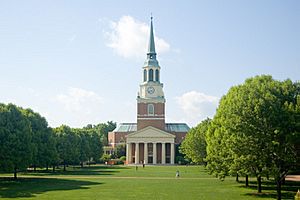
The School of Medicine moved to Winston-Salem in 1941. It became the Bowman Gray School of Medicine. In 1942, Wake Forest welcomed its first female undergraduate students. This happened because World War II meant fewer male students were available.
In 1946, with big donations from the Z. Smith Reynolds Foundation, the college decided to move. The new campus in Winston-Salem opened in the fall of 1956. Charles and Mary Reynolds Babcock donated about 330 acres of their estate, "Reynolda". From 1952 to 1956, 14 new buildings were built in a Georgian style. The old campus was sold to start the Southeastern Baptist Theological Seminary.
Welcoming Everyone
On April 27, 1962, Wake Forest decided to accept Edward Reynolds. He was from Ghana and became the first black full-time undergraduate student. This made Wake Forest the first major private university in the South to welcome students of all races. Edward Reynolds graduated in 1964 with a history degree.
Other important steps for diversity at Wake Forest include:
- The first Asian graduate was Konsukie Akiyama in 1909.
- Women undergraduates were first admitted in 1942.
- James G. Jones, from the Lumbee nation, was the first American Indian graduate in 1958.
- On February 23, 1960, Wake Forest students joined others for a sit-in at a lunch counter in Winston-Salem.
- Martin Luther King Jr. spoke at Wait Chapel on October 11, 1962.
- Herman Eure and Dolly McPherson became the first black full-time professors in 1974.
- The Office of Minority Affairs started in 1978. It later became the Office of Multicultural Affairs. Other offices for diversity were also added.
- In 1982, the famous poet and author Maya Angelou became a professor.
- In 2002, Wake Forest added a cultural diversity class requirement.
Recent Times
A program for graduate studies began in 1961. In 1967, the school officially became Wake Forest University. The School of Business was started in 1969.
In 1979, Wake Forest began to change its relationship with the Baptist State Convention. This was to gain more academic freedom. In 1986, the school became independent from the Convention.
Nathan O. Hatch became the university's 13th president in 2005. He retired in 2020. On January 29, 2021, Susan Rae Wente was named the 14th president. She is the first female president of Wake Forest.
In 2015, Wake Forest planned to offer undergraduate classes in the Innovation Quarter downtown. These programs, including biomedical sciences and engineering, opened in January 2017.
In 2020, Wake Forest officially apologized for benefiting from slavery in the past.
Wake Forest Baptist Medical Center and Atrium Health announced a partnership in 2019. They plan to open a new campus for the School of Medicine in Charlotte by 2024.
Political Events
Wake Forest has hosted important political events. In 1978, President Jimmy Carter gave a speech about national security. The school has also hosted two presidential debates. One was in 1988 between George H. W. Bush and Michael Dukakis. The other was in 2000 between George W. Bush and Al Gore. Both debates were held in Wait Chapel.
University Campuses
Reynolda Campus
The Reynolda Campus is the main campus of Wake Forest University. It has the undergraduate colleges and most of the graduate schools. The campus has two main areas, North and South Campus, separated by Reynolda Hall.
North Campus has Hearn Plaza, also known as "the quad." It has student dorms, a restaurant, stores, and Wait Chapel. The Divinity School and Religion Department are also in Wait Chapel.
South Campus has Manchester Quad, named after donors Doug and Elizabeth Manchester. It has freshman dorms, most classrooms, the Benson Center, and the Z. Smith Reynolds Library.
Reynolda House Museum of American Art
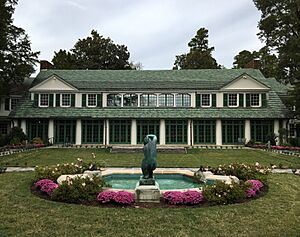
The Reynolda House Museum of American Art is a key part of the Reynolda Estate. The university's main campus is named after this estate. The house was built in 1917 by Katharine Smith Reynolds and her husband, Richard Joshua Reynolds. He founded the R.J. Reynolds Tobacco Company. It became an art museum in 1967 and has been connected to Wake Forest University since 2002.
Reynolda House shows American art from different time periods. It includes works by famous artists like Mary Cassatt and Georgia O'Keeffe. Wake Forest students can intern, volunteer, and do research at the museum. Students and university employees can visit the museum for free.
Reynolda Gardens
Reynolda Gardens covers 129 acres. It was once part of the R. J. Reynolds family estate. The gardens include a lake, a golf course, formal gardens, and woods. Today, it is a learning center for plants, the environment, and landscape history. Wake Forest students and teachers do research here. The public can also take classes and attend events.
Reynolda Village
Next to the Wake Forest campus is Reynolda Village. It has stores, restaurants, and offices. Wake Forest University now owns and runs these buildings. They were originally part of the R. J. Reynolds family's large estate. The buildings were designed to look like an English village.
Graylyn International Conference Center
Wake Forest University also owns and manages Graylyn. This was built as a private home for Bowman Gray, Sr., and his family in 1932. The Gray family lived there until 1946. It was then given to the Bowman Gray School of Medicine. In 1972, it was given to Wake Forest University. It is now a top meeting place.
Other Winston-Salem Campuses
The Bowman Gray Campus is near downtown Winston-Salem. It is home to Atrium Health Wake Forest Baptist. This includes the Wake Forest School of Medicine and its hospitals. With about 13,000 employees, it is the largest employer in the area. Wake Downtown is located in the Wake Forest Innovation Quarter.
Wake Forest bought the Lawrence Joel Veterans Memorial Coliseum and 33 acres around it in 2013. The Coliseum is where Wake Forest's men's and women's basketball teams play.
Wake Forest Innovation Quarter
The Wake Forest Innovation Quarter is in downtown Winston-Salem. It used to be called Piedmont Triad Research Park. Wake Forest Biotech Place opened here in 2012. It is a large research and innovation center. Several School of Medicine departments and private companies are located here.
In 2012, Wake Forest Baptist Medical Center started Wake Forest Innovations. This group helps turn new ideas and discoveries into useful products and services. Undergraduate programs began at Wake Downtown in January 2017.
University Corporate Center
This large building was once the main office for Reynolds Tobacco Company. RJR Nabisco donated it to Wake Forest University in 1987. It is now called the University Corporate Center. It houses many university offices and other businesses.
Charlotte Campus
The School of Business opened a campus in Charlotte, North Carolina, in 1995. In 2001, it moved to a new, award-winning building in Uptown.
The Charlotte Center offers MBA programs for working professionals. It also has courses for continuing education and special events. The center is a place for students and alumni to learn and gather.
Washington, D.C. Campus
The university's Washington, D.C. campus offers undergraduate and law classes. The Wake Washington Center also hosts workshops, networking events, and speaker panels for alumni.
Overseas Campuses
Wake Forest University owns properties in Italy, Austria, and England. These are used for study abroad programs.
Venice
In 1974, Wake Forest bought a building in Venice that used to be the American Consulate. It was named Casa Artom. It is a two-story building on the Grand Canal. Each fall and spring, a group of Wake Forest students and a professor live and study here.
Vienna
In 1998, Wake Forest bought a three-story house in Vienna. It was named Flow House after the donors. Built in 1898, it used to be the U.S. Consulate office. Students and a professor live and study here each fall and spring.
London
In 1977, Wake Forest got a large brick home in Hampstead for its London program. It was a gift from Eugene and Ann Worrell and named in their honor. The building was once the home and studio of a painter. Students and a professor live and study here each fall and spring.
Academics and Learning
| Admissions statistics | |
|---|---|
|
2023 entering
classChange vs. 2018 |
|
| Admit rate | 21.56%
(
|
| Yield rate | 36.75%
(
|
| Test scores middle 50% | |
| SAT Total | 1410–1500 (among 26% of FTFs for Fall 2023) |
| ACT Composite | 32–34 (among 22% of FTFs for Fall 2023) |
Becoming a Student
Getting into Wake Forest as an undergraduate is considered "most selective." For students starting in fall 2023, the university received over 17,000 applications and accepted about 21.56 percent. About 1,385 students chose to enroll.
Wake Forest University does not require students to submit SAT or ACT scores. Students can decide if they want their test scores to be considered. For those who did submit scores, the middle 50 percent of SAT scores were between 1410 and 1500. For ACT scores, the middle 50 percent was between 32 and 34.
The cost of attending Wake Forest is among the highest in North Carolina.
What Students Learn
Wake Forest offers 49 main subjects (majors) and 60 smaller subjects (minors). Students usually choose their major in their second year.
To graduate, students need 120 hours of credit. This includes a set of core classes, classes for their major, and elective classes. Core classes include a first-year seminar, writing, health, and foreign language. Students also take classes in humanities, social sciences, math, and natural sciences.
Wake Forest also has an "Open Curriculum" option. A small number of students can design their own study plan with a teacher's help.
The School of Business offers programs in accounting, business management, finance, and mathematical business. Students can earn both a bachelor's and master's degree in accounting.
Wake Forest has many centers and institutes. These help students learn across different subjects. Examples include Nanotechnology and Molecular Materials, and Bioethics, Health and Society.
Teachers and Professors
The university has nearly 2,000 faculty members. Most of them work full-time. About 93 percent of undergraduate teachers have high-level degrees in their fields. Wake Forest is known for its excellent teaching. There is one teacher for every 11 students.
Some well-known teachers include:
- Anthony Atala, who is a leader in growing organs for medicine.
- David Carroll, who researches new technologies for cancer and green energy.
- Melissa Harris-Perry, a professor of politics and former TV host.
- Former President Nathan O. Hatch, a famous religious historian.
- Author and civil rights activist Maya Angelou, who taught at the university from 1982 until her passing in 2014.
Studying Abroad
Wake Forest offers over 400 study abroad programs. These programs are for a semester, summer, or full year. They are in 200 cities in more than 70 countries.
Wake Forest has its own houses in:
In these houses, a professor leads a group of students who live and study together.
Other university-sponsored programs are in Santiago, Chile; Dijon, France; Cambridge, England; Salamanca, Spain; and Hirakata, Japan.
Programs for High School Students
Wake Forest University has programs for high school students. These "pre-college immersion programs" help students explore different subjects before college. They can choose from Summer Immersion (on campus) or Online Immersion programs. These programs are led by Wake Forest faculty and staff.
Graduate and Professional Schools
| School founding | |
|---|---|
| School | Year founded |
| Wake Forest School of Law | 1894 |
| Wake Forest School of Medicine | 1902 |
| Wake Forest University School of Business | 1948 |
| Wake Forest Graduate School of Arts and Sciences | 1961 |
| Wake Forest University School of Divinity | 1999 |
| Wake Forest University School of Professional Studies | 2021 |
Besides the undergraduate college, Wake Forest University has a Graduate School of Arts and Sciences and four professional schools.
Graduate School of Arts and Sciences
This school offers 25 graduate programs and 11 certificates. Students can earn Ph.D. degrees in sciences and master's degrees in arts and sciences. There are also joint degree programs with other schools.
School of Business
The Wake Forest School of Business started in 1969. It has both graduate and undergraduate programs. The main campus has a new building called Farrell Hall. There is also a campus in Charlotte for working professionals.
The school offers seven master's programs and four joint-degree programs. These include Master of Business Administration (MBA) and Master of Science in Accountancy. Undergraduates can earn a Bachelor of Science (BS) degree in subjects like accounting and finance.
School of Divinity
The School of Divinity offers a Master of Divinity degree. It also has programs in bioethics, counseling, and law. The school works with the School of Medicine on a certificate in Spirituality and Health.
The school has 18 faculty members. It aims to be "Christian by tradition, Baptist in heritage, and ecumenical in outlook." Planning for the school began in 1989. The first students enrolled in 1999, and the first degrees were given in 2002.
School of Law
The Wake Forest University School of Law is a private law school. It started in 1894. U.S. News & World Report often ranks it among the top law schools in the country. The school has 52 full-time faculty members.
The law school offers several degrees, including the JD. Class sizes are small, with first-year classes limited to 40 students.
School of Medicine
The Wake Forest School of Medicine has two campuses in Winston-Salem. One is on the Bowman Gray Campus, and the other opened downtown in 2016. It was founded in 1902. The school teaches about 1,800 students and fellows each year. It is connected to Wake Forest Baptist Health.
The School of Medicine offers degrees like MD, PhD, and MS. It also has joint-degree programs. The school ranks high in funding from the National Institutes of Health (NIH). In November 2023, the School of Medicine promised $100 million to help fund research.
Rankings and Reputation
| ARWU World | 501–600 |
|---|---|
| THES World | 401–500 |
| USNWR National University | 46 |
| Washington Monthly National University | 71 |
| Forbes | 88 |
| Biological Sciences | 112 |
| Chemistry | 119 |
| Law | 25 |
| Medicine: Primary Care | 68 |
| Medicine: Research | 52 |
| Nursing–Anesthesia | 10 |
| Physician Assistant | 7 |
| Physics | 110 |
In 2023, U.S. News & World Report ranked Wake Forest tied for 47th among national universities in the U.S. It was also ranked 31st for "Best Undergraduate Teaching." In 2024, it was ranked 3rd among best national universities in North Carolina.
University Press
Wake Forest University Press started in 1976. It focuses strongly on Irish poetry. It has published many famous Irish poets.
Campus Life
| Race and ethnicity | Total | ||
|---|---|---|---|
| White | 69% |
|
|
| Foreign national | 9% |
|
|
| Hispanic | 8% |
|
|
| Black | 6% |
|
|
| Other | 4% |
|
|
| Asian | 4% |
|
|
| Economic diversity | |||
| Low-income | 9% |
|
|
| Affluent | 91% |
|
|
Student Groups
There are over 225 student organizations at Wake Forest. These include sports clubs, academic groups, and artistic clubs. Religious groups are also available. Both the College Republicans and College Democrats have active chapters. Students can also join performing groups like comedy troupes.
The Office of Student Engagement helps manage all student groups. It also organizes leadership activities for students.
Student Union
The Student Union is a student-run group that plans events. They organize Homecoming, Family Weekend, lectures, and concerts. A popular event is "Shag on the Mag," where students dance to live music during Springfest.
Student Government
Wake Forest Student Government (SG) started in 1923. It has a student body president, speaker of the house, secretary, and treasurer. These leaders work with a cabinet and senate to represent students. The senate has about 60 members. They work on student needs like academics and campus life.
Student Media
- WAKE Radio started in 1985.
- The Student is a website created by students in 2004. It shares news about campus activities.
- The Old Gold & Black (OGB) is the university's newspaper. It started in 1916. It is named after the school colors.
- Wake Forest Review is a student newspaper that shares news from a conservative viewpoint.
- Wake TV is the university's television channel. It has weekly news and entertainment shows.
- Wake Forest Journal of Business and Intellectual Property Law is a law journal run by students.
- Wake Forest Law Review is another law journal edited by students.
- The Howler is the annual yearbook.
- 3 to 4 Ounces is the campus literary magazine. It publishes student writing and art. It is the oldest media group on campus, starting in 1882.
WFDD Radio Station
WFDD is a public radio station affiliated with NPR. It started in 1946. The station broadcasts to 32 counties in North Carolina and Virginia. It has been on 88.5 FM since 1967.
Debate Team
The Wake Forest Debate team has won the National Debate Tournament twice, in 1997 and 2008. They have also reached the finals and semifinals many times. Two coaches have won the "National Coach of the Year" award.
In 2010, Wake Forest became the first top debate team to share all its evidence and arguments online. This helps other debaters.
Volunteer Service Corps
The Volunteer Service Corps (VSC) is a popular student group. It organizes volunteering locally and internationally. They have annual trips to places like Russia, Vietnam, and Latin America. After Hurricane Katrina, VSC sent students to help in the affected areas.
Army ROTC
Wake Forest University has an Army Reserve Officers' Training Corps (AROTC) program. Students in this program receive full scholarships, monthly payments, and money for books from the U.S. Army. The university also provides free room and board. This program is also open to students from Winston-Salem State University and Salem College.
Fraternities and Sororities
About 45 percent of undergraduate students are members of fraternity and sorority groups. Wake Forest requires new members to complete one semester of studies before joining.
Athletic Activities
Wake Forest offers classes like yoga, Pilates, and Zumba. Students also have 36 club sports teams that compete against other colleges. Over half of the students play in 18 different intramural sports. The university's fitness center, Reynolds Gym, was renovated in 2018 and is now called the Wake Forest Wellbeing Center.
Campus Safety
The Wake Forest University Police Department (WFUPD) keeps the campus safe. It has trained police officers, security officers, and communication officers.
Student Housing
Students are guaranteed housing for four years. Students are required to live on campus for their first three years.
The main housing areas are:
- South Campus (for first-year students): Babcock Hall, Bostwick Hall, Johnson Hall, Luter Hall, Collins Hall, South Hall, Angelou Hall.
- Quad Area (for upperclass students): Kitchin Hall, Davis Hall, Poteat/Huffman Halls, Taylor/Efird Halls.
- North Area (for upperclass students): Magnolia Hall, Dogwood Hall, Polo Hall, Martin Hall, Palmer Hall, Piccolo Hall, North Campus Apartments, Student Apartments, Polo Road houses area.
Personal and Career Development
In 2009, President Nathan Hatch started a plan to help students with their personal and career development. He created a new position and hired Andy Chan to lead this effort.
This work has included a national conference in 2012 with Condoleezza Rice. Wake Forest has also increased its staff and added "College to Career" courses.
Arts at Wake Forest
Every student takes at least one arts class before graduating. These include art history, studio art, theater, dance, and music. In 2011–2012, over 500 students were involved in performances. There were also 110 public art shows. Winston-Salem, the university's home, is known as the "City of Arts & Innovation."
Students can also enjoy other art opportunities:
- The WFU Art Collections have over 1,600 artworks. Students help choose new art for the collections.
- Students can easily visit the Reynolda House Museum of American Art and other art galleries.
- The Theatre Department allows students to perform from their first year.
- The Reynolda Film Festival is a free event with film screenings and workshops.
- The Secrest Artists Series offers free concerts by world-class musicians.
University Traditions
- Arnold Palmer Day: Celebrates PGA legend Arnold Palmer, who attended Wake Forest.
- Bell Tower/Tunnel Tours: Seniors can tour the tunnels of Wait Chapel and sign their names.
- Deacon Dash/First Year Field Run: First-year students run onto the field at the first football game.
- D.E.S.K: Local elementary students come to campus to create study spaces.
- CP3 Day: Celebrates former basketball alum and NBA player Chris Paul with doughnuts.
- Hit the Bricks: A charity event where students run around the Quad to raise money for cancer research.
- Lighting the Quad: The community celebrates the holiday season at Hearn Plaza.
- Lovefeast: A large Moravian-style celebration started in 1965.
- Pitsgiving: An annual Thanksgiving dinner for the Wake Forest community.
- President's Ball: A celebration for the university president, students, and staff.
- Pro Humanitate Days: Alumni, students, and staff volunteer around the world.
- Project Pumpkin: A student-led event that brings local children to campus for a fall festival and trick-or-treating.
- Rolling The Quad: Students celebrate athletic wins by covering the quad and trees with Toilet Paper. This is especially done after wins against rival teams.
- Wake 'N Shake: Students stay awake and on their feet for 12 hours to raise money and awareness for cancer.
School Songs
The university's alma mater is "Dear Old Wake Forest." The fight song is "O Here's To Wake Forest." These songs are played at events like graduation and sports games.
Screamin' Demons
Many students attend Wake Forest Football and Basketball games. This is partly due to the "Screamin' Demons" program. Students pay a fee to get the best seats and special shirts. They get automatic entry to sporting events.
Athletics
Wake Forest's athletic teams were first called The Old Gold and Black or the Baptists. In 1923, after a big win against the Duke Blue Devils, a reporter wrote that the Deacons "fought like Demons." This led to the current team name, the "Demon Deacons."
Wake Forest teams have won ten national championships in five different sports. The women's field hockey team has won three (2002, 2003, 2004). The men's golf team has won three (1974, 1975, 1986). The men's soccer team won in 2007. The baseball team won in 1955. The men's tennis team won in 2018. The women's golf team won in 2023. Wake Forest has a 96% graduation rate for student athletes.
Wake Forest is part of "Tobacco Road" or "The Big Four." These terms refer to the four North Carolina schools that have strong rivalries in the ACC. These schools are Duke, North Carolina, North Carolina State, and Wake Forest.
The Wake Forest Demon Deacons play in the NCAA's Division I. They are part of the Atlantic Coast Conference. Men's sports include baseball, basketball, football, golf, soccer, and tennis. Women's sports include basketball, field hockey, golf, soccer, tennis, and volleyball.
Football
Wake Forest plays its home football games at Allegacy Federal Credit Union Stadium. The Demon Deacons have won two ACC Football Championships. They have also had four players named ACC Player of the Year. The team has played in 15 bowl games.
Men's and Women's Basketball
Wake Forest is known for its competitive men's basketball program. They have won four ACC tournament titles. They have also played in the NCAA tournament 23 times. They reached the Final Four once in 1962.
Famous basketball alumni include Billy Packer, Muggsy Bogues, Randolph Childress, Chris Paul, and Tim Duncan.
The Wake Forest Demon Deacons women's basketball team is also competitive. Jen Hoover, a former player, became the coach in 2012. She is the program's all-time leading scorer. The team made its only NCAA tournament appearance in 1988. Dearica Hamby was drafted into the WNBA in 2015. Lawrence Joel Veterans Memorial Coliseum is the home court for both basketball teams.
Women's Field Hockey
The women's field hockey team has won three national championships in a row. They won in 2002, 2003, and 2004. Jennifer Averill is the head coach.
Golf
Wake Forest has had very successful golf teams. They won national championships in 1974, 1975, and 1986. Many well-known golfers have played for Wake Forest. These include Jay Haas, Billy Andrade, Arnold Palmer, and Tim Duncan.
Soccer
Wake Forest is a strong contender for national titles in men's soccer. Many players from the program have gone on to play professionally. In 2007, the team won the NCAA Men's Soccer Championship. They beat Ohio State 2–1. They also reached the NCAA Championship game in 2016.
Baseball
Wake Forest won the 1955 College World Series in baseball. In 2009, the team started playing at David F. Couch Ballpark. In 2017, eight players were chosen in the 2017 MLB Draft. This was the most in the team's history.
Tennis
Noah Rubin played for Wake Forest. He won the 2014 Wimbledon boys singles championship. In 2015, he was the runner-up in the NCAA singles championship.
On May 22, 2018, the Wake Forest Men's Tennis team won its first ever NCAA National Championship. They won on their home courts, beating Ohio State 4–2. Wake Forest was ranked as the number one team for most of that season.
Famous Alumni
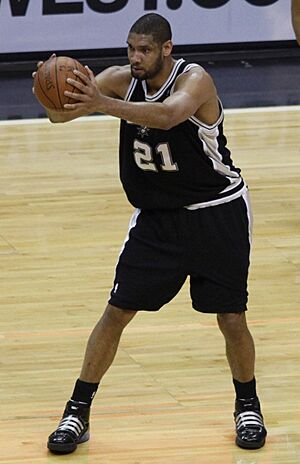
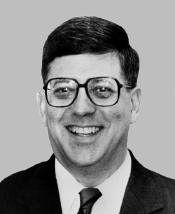
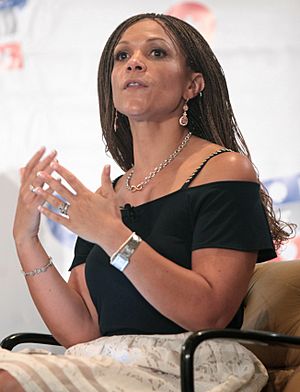
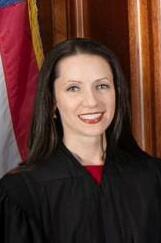


Wake Forest has over 82,000 living alumni. About 39% live in North Carolina. Others live in 97 different countries. Many alumni have achieved great things. This includes 18 Rhodes Scholars and 15 Truman Scholars.
Famous alumni in sports include:
- NBA players Muggsy Bogues (1987), Tim Duncan (1997), Josh Howard (2003), Jeff Teague, and Chris Paul.
- Legendary PGA golfer Arnold Palmer (1951).
- NFL players Norm Snead, Billy Ray Barnes, Bill George, and Brian Piccolo.
Alumni in politics and government include:
- Richard Burr (1982), former U.S. Senator from North Carolina.
- Ted Budd (2007), U.S. Senator from North Carolina.
- Bob Ehrlich (1982), former Governor of Maryland.
- Kay Hagan (1978), former U.S. Senator from North Carolina.
- Robert Wilkie, former U.S. Secretary of Veterans Affairs.
Wake Forest alumni in entertainment and media include:
- Actor Marc Blucas (1994).
- Cheslie Kryst (2017), Miss USA 2019.
- Melissa Harris-Perry (1994), author and professor.
- Al Hunt (1965) of Bloomberg News.
Business alumni include:
- Charlie Ergen (1976), co-founder of EchoStar and Dish Network.
- David Farr (1977), former CEO of Emerson Electric Company.
- Joseph W. Luter III of Smithfield Foods.
Many Wake Forest alumni have also become presidents of other colleges and institutions.
See also
 In Spanish: Universidad de Wake Forest para niños
In Spanish: Universidad de Wake Forest para niños
- Wake Forest Baptist Church
- Baptist State Convention of North Carolina
- List of Wake Forest University people
- Wake Forest University Press
- Southern Ivy


